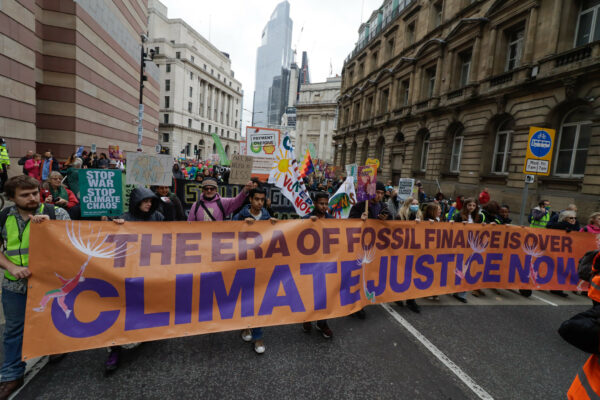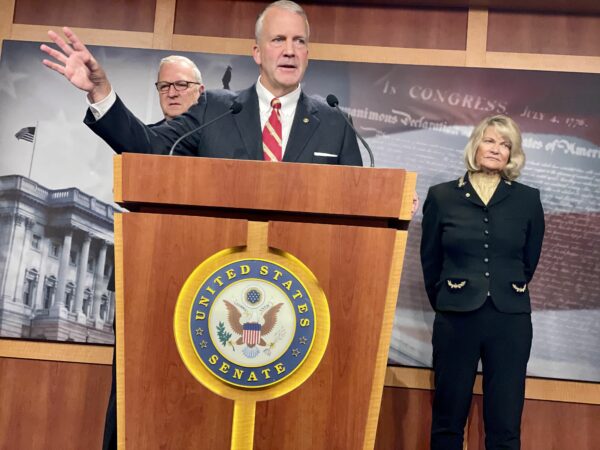
In the climate debate, natural gas is cast as both hero and villain.
For protestors at the COP26 climate conference in Glasgow, producing and burning natural gas is unequivocally bad, a danger to the planet.
“We cannot have any fossil fuel development if we are to have a fighting chance of staying below 1.5 degrees,” said one demonstrator, in video captured by Reuters.
Leaders at the U.N. conference held Oct. 31 to Nov. 13 pledged to reduce emissions of methane, the main component of natural gas. Some countries promised not to permit new gas production.
Meanwhile, as COP26 was underway, U.S. Sen. Dan Sullivan was in Washington, D.C., unveiling what he’s calling “the American energy, jobs and climate plan.” He presents gas as a climate solution.
“Our vision emphasizes leadership and clean energy innovation, and resources — like natural gas,” he said, with extra emphasis, “to both expand the use at home in export abroad as a central way to lower global emissions.”

What protestors, the public and corporate shareholders think about gas could influence whether Alaska is ever going to build a pipeline to bring its massive gas reserves from the North Slope to world markets. Someone would have to pony up nearly $40 billion for that project. So far, banks and oil companies haven’t been willing to, and popular opinion about all fossil fuels is pulling in the opposite direction.
Sullivan’s plan isn’t a bill. He, Sen. Ted Cruz of Texas and other Republican senators presented it at a press conference on poster boards and a glossy handout. Sullivan said he wanted to provide an alternative to the message from Glasgow.
On the Republican stage, natural gas is cast as a climate change savior for replacing coal at power plants, particularly in China and India. As fuel, coal produces almost twice the greenhouse gas emissions of natural gas for the same amount of energy.
But climate advocates call on coal-reliant countries to switch to renewable energy. They note that gas, when burned, still releases a significant amount of carbon. And they say gas is culpable long before it reaches a combustion chamber.
Methane is an especially potent greenhouse gas when it leaks into the atmosphere. One report, sponsored by an environmental group, asserts that when you look at all the emissions that escape during gas production and transportation, and the energy that’s put into super-cooling it for shipping, liquified natural gas is almost as bad for the atmosphere as coal, in the near term.
A lot of important points are lost when you paint gas in such broad brushstrokes, said retired engineer Cathy Foerster. For instance, some gas production is cleaner than others.
“Gas by itself is way better than coal,” she said. “How people handle the gas is what determines whether it is better than coal ultimately.”
Foerster recently served on the Alaska Oil and Gas Conservation Commission, which is charged with ensuring state-owned petroleum resources aren’t squandered. Foerster said the commission has done a good job of requiring companies to re-inject North Slope gas back into the reservoir and prevent it from escaping.
“Any time any natural gas is flared or vented for greater than one hour, the operator must report to the AOGCC the volume of gas vented the time it occurred and provide a reason for it,” she said.
[Sign up for Alaska Public Media’s daily newsletter to get our top stories delivered to your inbox.]
If the reason isn’t safety or to conserve the resource, she said, the company is fined.
She said policies that drive gas production overseas, to jurisdictions that aren’t as careful, don’t help. But Foerster wonders if Alaska will continue to be as successful at preventing methane emissions. Major oil and gas companies developed most of Alaska’s industry. Now the fields are in decline and the majors are giving way to more independent operators. As Foerster sees it, the independents present a lot of unknowns.
“They may pay lower attention to some of the mechanical integrity and safety-related expenditures that the majors put a higher emphasis on,” she said. “And if they do de-emphasize those areas, it puts Alaska at a greater risk of increased emissions and safety concerns.”
Foerster said the fuel itself isn’t good or bad. What matters, in her book, is how it’s brought out of the ground and moved around.
Former Democratic legislator Kay Brown takes a dimmer view of natural gas.
“Gas is the new coal,” she said.
Brown used to be Alaska’s director of oil and gas. She used to promote the building of a gas pipeline. Now she’s Arctic policy director of Pacific Environment, a coalition of activist groups. She said Alaskans have to give up the long-held dream of a gas pipeline, to prevent the worst effects of climate change.
“Natural gas is more harmful as a short-term climate pollutant than carbon dioxide,” she said. “And most of the natural gas reserves that have already been discovered need to stay in the ground and not be produced.”
The economic feasibility of Alaska’s gas line was always a hard sell. Brown said it will only get worse as the world moves away from fossil fuels and gas falls further from favor.
Liz Ruskin is the Washington, D.C., correspondent at Alaska Public Media. Reach her at lruskin@alaskapublic.org. Read more about Liz here.





